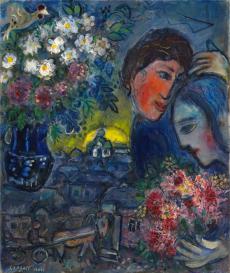


T here is a wealth of biographical data about Marc Chagall that helps us shed light on his art. Born in 1887, in Vitebsk, Belarus, to a practising Jewish family, in 1907 he began his studies in St Petersburg, where one of his teachers was Léon Bakst (1866-1924), known for his ties to the Ballets Russes. His first sojourn in Paris (1910- 1914) allowed him to discover the great masters of the recent past: Paul Gauguin (1848-1903), Paul Cézanne (1839-1906) and Vincent van Gogh (1853-1890). He also associated with such representatives of the literary and artistic avant-garde as Blaise Cendrars (1887-1961), Guillaume Apollinaire (1880-1918), Max Jacob (1876-1944), Fernand Léger (1881-1955), Amedeo Modigliani (1884-1920) and André Lhote (1885-1962). Chagall’s art – a veritable explosion of colour, using an iconography nurtured by his memories of the Vitebsk ghetto, in which background and figures, reality and the imaginary world interpenetrate – was well received, and his profound originality was recognised from the outset. Returning to Russia in 1914, he was caught unawares by the war and stayed there until 1922. This was a very active period, during which he worked primarily on the decor of the State Jewish Theatre in Moscow. His disagreements with the Suprematists led him to return to Paris via Berlin. In 1924, he had his first retrospective in Paris. The art dealer and publisher Ambroise Vollard (1886-1939) proposed a series of projects involving book illustrations, especially on the themes of the circus and the Bible, an iconography which is omnipresent in his painting. Chagall travelled extensively in Europe and America, where he found refuge during World War II. After the war, he returned to France, dividing his time among large-scale decorative projects (the Biblical Message series, 1955-1966, now in the Musée Marc Chagall, Nice; the ceiling of the Paris Opéra, 1963-1964; murals for the Lincoln Art Center in New York, 1965-1966; stained-glass windows in France, Israel and the US, as well as tapestries), stage designs, easel paintings and an abundance of etchings and lithographs.
Les Fiancés au Bouquet, a canvas he started in 1954 and to which he kept returning until 1963 (according to a notation in the exhibition catalogue of the Fondation Maeght, Saint-Paul-de-Vence, where it was shown in 1967), belongs to a happy and productive period in Chagall’s career. The painter, living in Vence, in the Midi region of France, was working concurrently on decorative projects for the theatre and various buildings, as well as on individual canvases. A widower, following the death in 1944 of his wife Bella, in 1952 he remarried Valentina Brodsky, known as ‘Vava’, and the theme of the couple (in love, married, portrayed with bunches of flowers – a symbol of fulfilment and fecundity which is present in Chagall’s painting from early on) acquired a new freshness in this autobiographical context. Reduced to two simple masks and two hands inscribed inside a crescent, the figures are inseparable from the intensely laboured background. A rising sun illuminates the darkened space; the village, with its horse-drawn cart, could again be Vitebsk, unless it evokes Vence, as in a similar composition (Les Amoureux de Vence, 1957, private collection; reproduced in Franz Meyer, Marc Chagall, Paris 1964, p. 557), or the little neighbouring village of Saint-Jeannet, which appears in numerous paintings of this period. One must, however, be wary of such spontaneous interpretations: ‘An animal,’ Chagall tells us, ‘can sometimes assume the form of an object. Another object can bring to mind a bunch of flowers, while an actual bouquet is transfigured into a house. People walking in the back, at the front, or moving backwards on different planes. More than the meaning of these elements, I wish to underscore their value, their constructive character in the architecture of my paintings. Which in no way prevents them from being born spontaneously.’ The painter also noted: ‘Remember that my painting isn’t really European. It is part-oriental. Colour and material – that’s what counts for me. I’m not interested in the formal aspect of a painting.’
An exceptional figure in an era crisscrossed by countless movements and schools, Chagall did not let himself become a slave to any one of them, but chose to represent an imaginary, symbolic world, nurtured by biblical scriptures and his personal memories, and to impose a reign of colour. It is this extreme originality, which is immediately identifiable, that made him one of the most universally known and loved painters of the 20th century.
The tremendous individuality of this 20th-century master makes his work instantly recognisable and universally admired. Unswayed by contemporary art movements, his unique style and often autobiographical subjects, mingled with elements of Jewish folk culture, combined to create an imaginary, symbolic world dominated by bright colours. He studied in St Petersburg with Léon Bakst and then went to Paris (1910-1914), where he discovered the works of Paul Gauguin, Paul Cézanne and Vincent van Gogh. He returned to Russia in 1914 and stayed until 1922 because of World War I; during World War II, he lived in America and then returned to France. Other than painting, he made book illustrations, large-scale decorative projects, stage designs, tapestries, stained-glass windows and many etchings and lithographs.